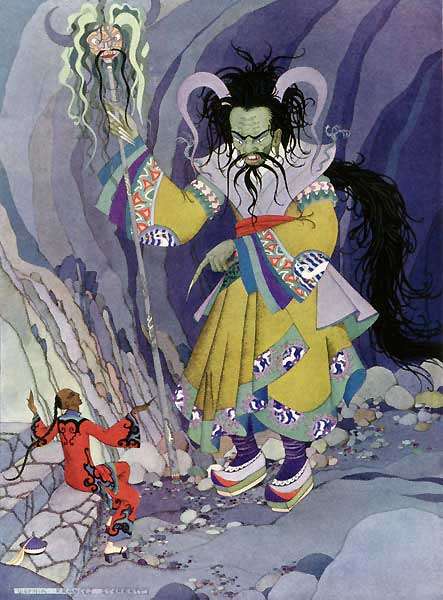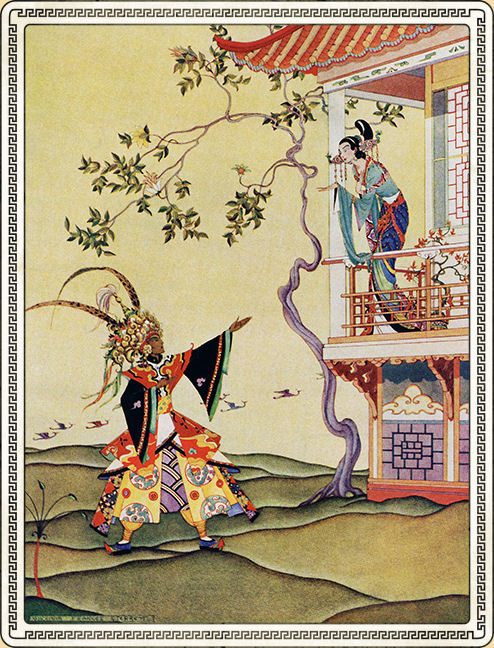Found this interesting article recently. beda dengan gambaran kita selama ini bahwa aladdin adalah seorang arab seperti yg ada di film Aladdin buatan disney itu.
In the original story, Aladdin is represented as the son of a Chinese tailor. Princess Jasmine is actually called Badroulbadour, and she is the daughter of the Chinese "Sultan."
here some synopsis:
Quote:
Aladdin is an impoverished young ne'er-do-well in a Chinese city, who is recruited by a sorcerer from the Maghreb, who passes himself off as the brother of Aladdin's late father, convincing Aladdin and his mother of his goodwill by apparently making arrangements to set up the lad as a wealthy merchant. The sorcerer's real motive is to persuade young Aladdin to retrieve a wonderful oil lamp from a booby-trapped magic cave. After the sorcerer attempts to double-cross him, Aladdin finds himself trapped in the cave. Fortunately, Aladdin retains a magic ring lent to him by the sorcerer. When he rubs his hands in despair, he inadvertently rubs the ring, and a jinni, or "genie", appears, who takes him home to his mother. Aladdin is still carrying the lamp, and when his mother tries to clean it, a second, far more powerful jinni appears, who is bound to do the bidding of the person holding the lamp. With the aid of the jinni of the lamp, Aladdin becomes rich and powerful and marries Princess Badroulbadour, the Emperor's daughter. The jinni builds Aladdin a wonderful palace far more magnificent than that of the Emperor himself.
The sorcerer returns and is able to get his hands on the lamp by tricking Aladdin's wife, who is unaware of the lamp's importance, by offering to exchange "new lamps for old". He orders the jinni of the lamp to take the palace to his home in the Maghreb. Fortunately, Aladdin retains the magic ring and is able to summon the lesser jinni. Although the jinni of the ring cannot directly undo any of the magic of the jinni of the lamp, he is able to transport Aladdin to Maghreb, and help him recover his wife and the lamp and defeat the sorcerer.
The sorcerer's more powerful and evil brother tries to destroy Aladdin for killing his brother by disguising himself as an old woman known for her healing powers. Badroulbadour falls for his disguise, and commands the "woman" to stay in her palace in case of any illnesses. Aladdin is warned of his danger by the jinni of the lamp and slays the imposter. Everyone lives happily ever after, Aladdin eventually succeeding to his father-in-law's throne.
Quote:
No Arabic source has been traced for the tale, which was incorporated into the book One Thousand and One Nights by its French translator, Antoine Galland, who heard it from an Arab Syrian storyteller from Aleppo. Galland's diary (March 25, 1709) records that he met the Maronite scholar, by name Youhenna Diab ("Hanna"), who had been brought from Aleppo to Paris by Paul Lucas, a celebrated French traveller. Galland's diary also tells that his translation of "Aladdin" was made in the winter of 170910. It was included in his volumes ix and x of the Nights, published in 1710.
John Payne, Aladdin and the Enchanted Lamp and Other Stories, (London 1901) gives details of Galland's encounter with the man he referred to as "Hanna" and the discovery in the Bibliothèque Nationale in Paris of two Arabic manuscripts containing Aladdin (with two more of the "interpolated" tales). One is a jumbled late 18th century Syrian version. The more interesting one, in a manuscript that belonged to the scholar M. Caussin de Perceval, is a copy of a manuscript made in Baghdad in 1703. It was purchased by the Bibliothèque Nationale at the end of the nineteenth century.
Although Aladdin is a Middle Eastern tale, the story is set in China, and Aladdin is explicitly Chinese.[3] However, the "China" of the story is an Islamic country, where most people are Muslims; there is a Jewish merchant who buys Aladdin's wares (and incidentally cheats him), but there is no mention of Buddhists or Confucians. Everybody in this country bears an Arabic name, and its monarch seems much more like a Muslim ruler than a Chinese emperor. Some commentators believe that this suggests that the story might be set in Turkestan (encompassing Central Asia and the modern Chinese province of Xinjiang).[4] It has to be said that this speculation depends on a knowledge of China that the teller of a folk tale (as opposed to a geographic expert) might well not possess,[5] and that a deliberately exotic setting is in any case a common storytelling device.
For a narrator unaware of the existence of America, Aladdin's "China" would represent "the Utter East" while the sorcerer's homeland in the Maghreb (Northern Africa) represented "the Utter West". In the beginning of the tale, the sorcerer's taking the effort to make such a long journey, the longest conceivable in the narrator's (and his listeners'

perception of the world, underlines the sorcerer's determination to gain the lamp and hence the lamp's great value. In the later episodes, the instantaneous transitions from the east to the west and back, performed effortlessly by the Jinn, make their power all the more marvelous.
Ternyata kisah Aladdin sendiri memang tidak ada di dalam cerita asli One Thousand and One Nights tapi ditambahkan ke dalam kumpulan cerita tersebut oleh translatornya Antoine Galland.
some pic of Aladdin by the famed illustrator Virginia Frances Sterrett in 1928
Aladdin and the Genie of the Ring

Aladdin Greeted the Princess with Joy

English translation
ALAEDDIN
copy of the original story by Galland
It's fuckin french
Be kind replier everyone..








 perception of the world, underlines the sorcerer's determination to gain the lamp and hence the lamp's great value. In the later episodes, the instantaneous transitions from the east to the west and back, performed effortlessly by the Jinn, make their power all the more marvelous.
perception of the world, underlines the sorcerer's determination to gain the lamp and hence the lamp's great value. In the later episodes, the instantaneous transitions from the east to the west and back, performed effortlessly by the Jinn, make their power all the more marvelous.